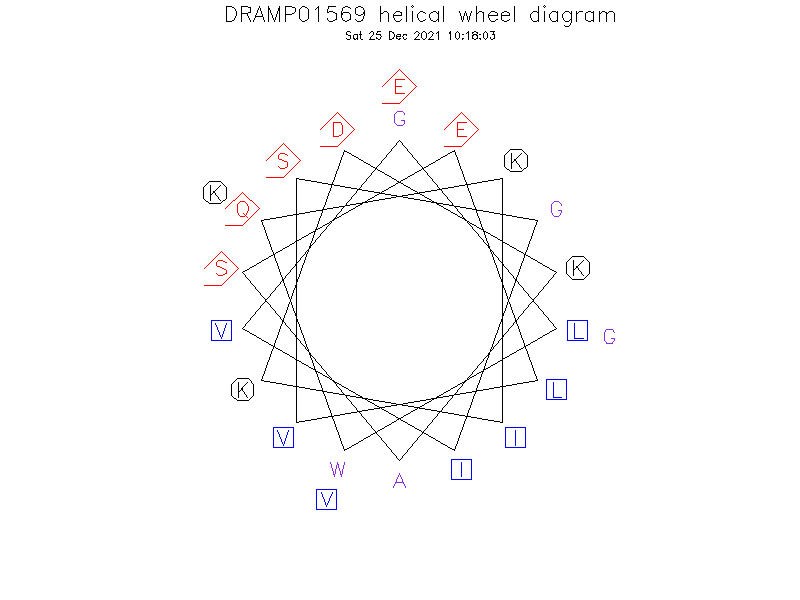General Information
-
DRAMP ID
- DRAMP01569
-
Peptide Name
- Caerin-3.1 (Frogs, amphibians, animals)
-
Source
- Litoria gilleni (Centralian tree frog) (Litoria splendida) (Litoria rothii)
-
Family
- Belongs to the frog skin active peptide family (Caerin subfamily)
-
Gene
- Not found
-
Sequence
- GLWQKIKDKASELVSGIVEGVK
-
Sequence Length
- 22
-
Protein Existence
- Protein level
Activity Information
-
Biological Activity
- Antimicrobial, Antibacterial, Anti-Gram+
-
Target Organism
-
- Gram-positive bacterium: Micrococcus luteus (MIC<0.4 µg/ml). (Ref.2)
-
Hemolytic Activity
-
- No hemolysis information or data found in the reference(s) presented in this entry
-
Cytotoxicity
-
- Not included yet
-
Binding Target
- Not found
Structure Information
-
Linear/Cyclic
- Not included yet
-
N-terminal Modification
- Not included yet
-
C-terminal Modification
- Not included yet
-
Nonterminal Modifications and Unusual Amino Acids
- Not included yet
-
Stereochemistry
- Not included yet
-
Structure
- Not found
-
Structure Description
- Not found
-
Helical Wheel Diagram
-
PDB ID
- None
-
Predicted Structure
- There is no predicted structure for DRAMP01569.
Physicochemical Information
-
Formula
- C108H182N28O32
Absent Amino Acids
- CFHMNPRTY
Common Amino Acids
- K
Mass
- 2384.8
PI
- 8.43
Basic Residues
- 4
Acidic Residues
- 3
Hydrophobic Residues
- 9
Net Charge
- +1
-
Boman Index
- -18.12
Hydrophobicity
- -0.105
Aliphatic Index
- 115
Half Life
-
- Mammalian:30 hour
- Yeast:>20 hour
- E.coli:>10 hour
Extinction Coefficient Cystines
- 5500
Absorbance 280nm
- 261.9
Polar Residues
- 5
DRAMP01569

Comments Information
Function
- Antibacterial peptide, that adopts an alpha helical conformation which can disrupt bacterial membranes. Each caerin displays a different antimicrobial specificity.
Tissue specificity
- Expressed by the skin parotoid and/or rostral glands.
PTM
- C-terminal amidation.
Literature Information
- ·Literature 1
-
Title
- Peptides from Australian frogs. The structures of the caerins from Litoria caerula.
-
Pubmed ID
- PubMed ID is not available
-
Reference
- J. Chem. Res. 1993; 138: 910-936.
-
Author
- Stone DJM, Waugh RJ, Bowie JH, Wallace JC, Tyler MJ.
- ·Literature 2
-
Title
- Host-defence peptides of Australian anurans: structure, mechanism of action and evolutionary significance.
-
Pubmed ID
- 15203252
-
Reference
- Peptides. 2004 Jun;25(6):1035-1054.
-
Author
- Apponyi MA, Pukala TL, Brinkworth CS, Maselli VM, Bowie JH, Tyler MJ, Booker GW, Wallace JC, Carver JA, Separovic F, Doyle J, Llewellyn LE.
- ·Literature 3
-
Title
- The rothein peptides from the skin secretion of Roth's tree frog Litoria rothii. Sequence determination using positive and negative ion electrospray mass spectrometry.
-
Pubmed ID
- 16124032
-
Reference
- Rapid Commun Mass Spectrom. 2005;19(18):2716-2724.
-
Author
- Brinkworth CS, Bowie JH, Bilusich D, Tyler MJ.
- ·Literature 4
-
Title
- Activities of seasonably variable caerulein and rothein skin peptides from the tree frogs Litoria splendida and Litoria rothii.
-
Pubmed ID
- 195396
-
Reference
- Toxicon. 2009 Nov;54(6):828-835.
-
Author
- Sherman PJ, Jackway RJ, Nicholson E, Musgrave IF, Boontheung P, Bowie JH.

